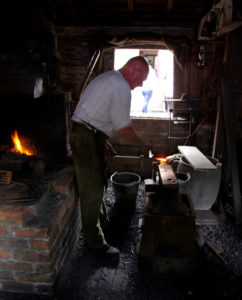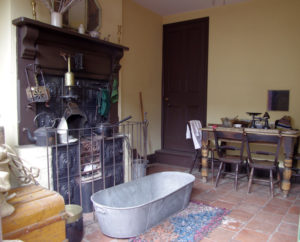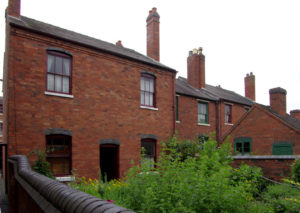The village street is a recreation of an early C20th street with a mixture of shops, houses, chapel and pub.
Methodism held a particular appeal for the poor and expanded rapidly in the industrial areas in at the start of the C19th. Every village had a Chapel.
The PROVIDENCE CHAPEL is a simple brick building with a small lobby and two doors – one for the men and a separate door for the women. Seating in the chapel was divided by a central wooden division. The inside is dominated by the tall pulpit. Above, painted on the wall is a banner “Worship the Lord in the Beauty of Holiness”. There is a gallery running round three sides of the chapel which is supported by fluted columns with ornate capitals. Being the 1940s weekend there was a display of wedding dresses.
The BOTTLE AND GLASS INN is at the bottom of the street and would originally have backed onto a canal. It is late C18th and was popular with boatmen, miners and brickmakers working on the canals. The horses were left to graze on the back lawn. There were regular fights and the pub was not considered a suitable place for women. Inside the door on the left is the public bar with snug on the right. The pub still serves traditional beers from local breweries.
To the side of the pub is the CARTER’S YARD. Horses were essential transport being used to haul canal barges and pull carts. Horses were unable to work long hours and needed to be changed before they became exhausted. The first building is the small tack room. Next to it is a stable with an over head hay loft. Next to it is the open cart shed with another stable and hay store next to it.
“GREGORY’S GENERAL STORE”:http://wasleys.org.uk/eleanor/presocialhistory/socialhistory/social/folkmuseums/blackcountrymuseum/bcm_four/index.html is very typical of a store that did literally sell everything from clothes to food, catering for those on low incomes who had difficulty in making ends meet. Initially it had been run from Mrs Gregory’s front room, but as trade increased, the house was converted to a double fronted shop with living quarters behind and above.
Meat and dairy products were sold at one end. Eggs were sold individually and butter by the penny’s worth. The family kept their own chickens and pigs which were reared for the shop.
Vegetables were displayed outside the shop. Dry goods and teas were sold from the middle counter.
At the opposite end were sweets, drapery and cigarettes. Cigarettes were usually sold singly rather than by the packet. Clothing and footwear could be ordered from a catalogue and were collected by Mrs Gregory once a week.
In the back yard was the wash house,. As well as doing the family washing, the boiler was used to make tripe that was sold in the shop. It was kept hot in the boiler and brought into the shop in a pot, a bit at a time. The family also baked bread to sell in the shop.
The “HARDWARE AND IRONMONGER’S SHOPS”:http://wasleys.org.uk/eleanor/presocialhistory/socialhistory/social/folkmuseums/blackcountrymuseum/bcm_five/index.html sell everything the housewife is likely to need from minor repairs around the house and garden to housewares. The shelves are packed with goods and more hang from the ceiling.
EMILE DOO’S CHEMIST SHOP is typical of a chemist shop of the time. Before the formation of the National Health Service, the chemist played a central role in the community as many people could not afford to pay to visit the doctor. The chemist provided free medical advice as well as administering basic first aid and weighing babies. They were even known to undertake dentistry and veterinary work. They made up all their own prescriptions.
T COOK’S SWEET SHOP is an old fashioned shop selling loose sweets from large glass jars. At the back is a large confectioner’s furnace used to boil up the sugar and glucose before colour and flavouring was kneaded into the molten sugar and then rolled into different shapes.
VEAL’S BAKERY sold bread baked in the oven at the back of the shop. The shop opened at 6am so workers could call in on their way to work to buy cobs or bread pudding to take to work with them. bread was sold by weight and often a family would only afford to buy a half or a quarter of a loaf. The shop also sold Crawford’s biscuits from large tins arranged on the back wall.
Next to the baker’s is is the PAWNBROKER’S SHOP. Pawning goods was quick way to raise a short term loan and was the only source of credit available to the poor. Families would pawn their possessions at the start of the week and then redeem them on a Friday or Saturday once they had their wages.
Pawnbroker’s were common in large industrial areas and were often run from converted houses.
The shop was in the front room and the articles to be pawned were taken as security against the loan. The value of the loan was determined by the amount the pawnbroker would raise by selling the item. The customer received the money and a ticket to redeem the item once the loan was repaid in full.
By law, all items had to be kept for a year. After this time, the pawnbroker was allowed to sell the item to recoup the loan.
There is also a fish and chip shop in the row and a small greengrocers.
STATION ROAD COTTAGES are actually a replica of two houses still standing on Station Road in Old Hill. These were built in the mid C19th and are typical industrial dwellings with a ground floor kitchen and pantry. The two bedrooms upstairs are reached by a staircase concealed behind a wooden door in the kitchen. In the back garden is a pig sty with a boiler on the side used for boiling up the pig swill.
At the end of Station Cottages is the NAIL SHOP. Nail working was one of the oldest specialist trades in the Black Country and in the mid C19th there were over 50,000 nail workers. Small workshops like this could be found in back yards.
The nail workers worked for mail masters (foggers) who supplied then with nail rod. They could make up to 2000 nails a day but it was poorly paid work. The building contained two hearths, which were centrally placed allowing several family members to work round it at the same time.
They made everything from hob nails to railway sleeper spikes. The rod was heated and continually beaten to a point, which also strengthen the wrought iron before the head was made and the final nail quenched.
With the introduction of machine made nails in the mid C19th, the number of hand nail makers dropped rapidly and few were made by hand by the end of the century.
Opposite Station Road Cottages are a pair of back to back houses. These were built in large numbers in industrial areas of the West Midlands to provide cheap high density housing for the working classes. Each had a ground floor living kitchen with a pantry and two small bedrooms on the first floor. In the back yard was the wash house and earth closet.
The ANCHOR MAKER’S HOUSE is next to Gregory’s General Store, with a side entry giving access to the back yard. It is typical of working class terrace housing built at the end of the C19th. It is a typical two up and two down house. The front door was rarely used, only for weddings and funerals.The front room was reserved for best and used on Sundays. The fireplace has a decorative glazed tile surround.
The back kitchen was the main living room and reached from the back door. All cooking was done at the ornamental cast iron range, which also provided hot water and heat. Between the two rooms was a small pantry.
The houses had a back garden used for growing vegetables to fed the family. The earth closet, wash house and small workshops were here. The earth closet was emptied regularly by the night soil man. Although the house belonged to an Anchor maker, the workshop is actually from that of a chain maker.
There are more pictures “here.”:http://wasleys.org.uk/eleanor/presocialhistory/socialhistory/social/folkmuseums/blackcountrymuseum/index.html










